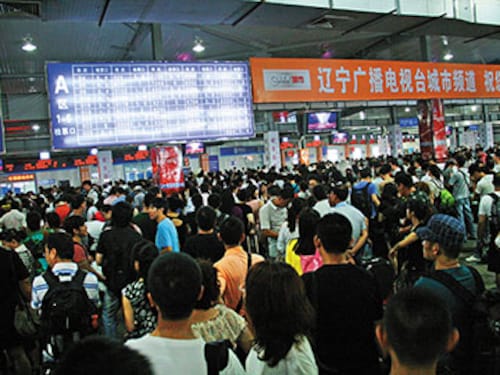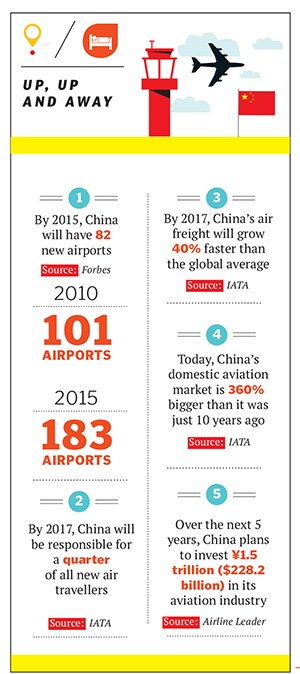Bridging the Cultural Gulf In China
As the volume of Sino-Indian trade rises steadily, more and more business travellers struggle to bridge the cultural gulf. We tell you how to get around it


So you’ve got your Chinese visa, your flight ticket, hotel booking. You’ve learned to say Ni Hao to greet someone and XieXie to thank him or her, and packed your suitcase with some Darjeeling tea, or fine leather folios to gift your potential business partner. You’re feeling proud of Mumbai’s new T2, or New Delhi’s T3 … and then your flight lands in Beijing’s Capital International Airport, the world’s second busiest airport, handling over 60 million people a year. As you make your way out of the gargantuan Norman Foster designed building, there’s an all-too familiar scrum of people holding up hotel or company signs. Except, most of them don’t speak English. If you’re lucky, or have arranged it in advance, you’ll be received at the airport and whisked to your hotel.
How do you make sure that your China business trip goes as smoothly as Shanghai’s Maglev train?
1. Collect your hotel and your business partner’s bilingual business cards. No matter where you are, this is what will get you back to your safe zone. Taxi drivers do not usually cheat, nor will they take a longer route to your destination. Also, keep the Indian embassy and consulate’s addresses with you. They’re very helpful in cases of emergencies.
2. When travelling by train, especially between the bigger cities like Beijing, Shanghai, Guangzhou or Hangzhou—make sure you know which station your train is leaving from. It’s no different from knowing if your train is departing from Mumbai Central or Mumbai VT, New Delhi or Hazrat Nizamuddin, Sealdah or Howrah. Keep enough time to get to the station—inner city or downtown traffic at peak hours can be bad.
3. If you need to make hotel, air or rail bookings within China, and have a secretary or business partner who will do it for you, write it all down. Remember that the Chinese write the year first, then the month and finally the date—a useful tip for fixing appointments, too. If you’re planning to book on your own (and you can), use the English version of Ctrip, China’s largest, most efficient travel portal. They even have an English-speaking hotline: 400-619-9999 (from within China).
4. Hotel rooms are aplenty in China, even in third and fourth tier cities. As a foreigner, you would probably be inclined to stay at one of the international chain hotels. IHG (Intercontinental, Crowne Plaza, Holiday Inn) has 170 properties, Starwood (Westin, St Regis, Sheraton) has 103, Wyndham 324, Marriott 58, and Shangri-La 33. Breakfast buffets are lavish and include Chinese and Western cuisine. I’ve had poori-aloo for breakfast at Shangri-La in Chengdu, and chicken curry in Wuhan. On the rare occasion, when a property fails to keep up to the standards of the international chain, they may pull out—even as the hotel’s English name stays on in the booking system (even Ctrip’s). I thought I was booked at the Marriott in Shenyang, only to find that it was the Marvelot.
5. Download Pleco to your smartphone.
The basic language translation app is free, but put down $14.95 and you get optical character recognition, which will translate anything written in Chinese into English.
6. If you want to make an impression without spending a lot, get an Uber limo. These sleek black cars are available in Shanghai (minimum fare $5), Guangzhou ($3.5) and Shenzhen ($4), at around double the cost of an ordinary taxi. A young Chinese entrepreneur told me that when he’d come to a business meeting in a taxi, his hit rate for closing deals was one in ten. Now that he has a BMW, it’s improved eightfold.
7. Avoid coming to China during the Golden Weeks (first week of May, first week of October) and Chinese New Year—no business will get done at the time. Ever since the Chinese government decreed that everyone must take a holiday at least twice a year, the population took it very seriously. International airlines hike their fares at the time (domestic airlines were forbidden to do so since last year), so a trip at those times will be doubly unproductive. 8. If you’re dining out without a local, try and find a place that has an English or bilingual menu. A local restaurant may have pictures on the menu, but you can’t make out if the fish dish is only the head, or—if you’re vegetarian—the stir fried spinach you ordered has a garnish of pork, or cooked in fish oil. If you want to be adventurous, use Pleco.
8. If you’re dining out without a local, try and find a place that has an English or bilingual menu. A local restaurant may have pictures on the menu, but you can’t make out if the fish dish is only the head, or—if you’re vegetarian—the stir fried spinach you ordered has a garnish of pork, or cooked in fish oil. If you want to be adventurous, use Pleco.
9. If you’re the guest of honour, you’ll be assigned a special seat and expected to raise a toast. The most senior (or privileged) person’s glass should always be higher when clinking glasses. Try to remember that even after six glasses of baiju.
10. Carry enough supplies of your essential medicines, and a good quality gas mask, like 3M.
I don’t want to scare you, but the air quality can sometimes get very, very bad, particularly in the big cities. Western medicines, particularly those manufactured by MNC pharma companies—if you can find them with their names written in English—can be several times as expensive as what you’d get in India, and international hospitals will rip you off. Get medical insurance even if you’re coming for a week. In an emergency, ask an English-speaking local to accompany you to a government hospital. Trust me, you’ll be better cared for.
Kunal Sinha is the chief knowledge officer at Ogilvy & Mather China, based in Shanghai
First Published: Feb 28, 2014, 07:05
Subscribe Now